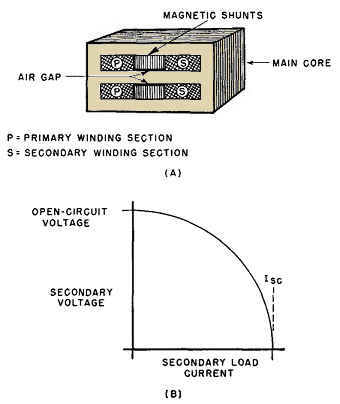| Electronic Transformers and Circuits is a free introductory textbook on transformers and related circuits. See the editorial for more information.... |

|

Home  Electronic Control Transformers Electronic Control Transformers  Current-Limiting Transformers Current-Limiting Transformers |
|||||






|
|||||
Current-Limiting Transformers
The same principle is used to limit current in transformers for oil-burner ignition, precipi-trons, and neon or other gas-filled tube signs. Cross-sectional area through each shunt path is the same as that of the upper or lower leg of the shell laminations; then flux in the shunts does not exceed that in the core, shunt iron loss is not abnormal, and secondary voltage is sinusoidal. At short-circuit current Isc, half the total flux flows through each set of shunts. The air-gap length in each shunt path can be found from equation 35:
where N = secondary turns Bm = allowable induction in the shunts (in gauss). The constant 0.6 is generally too small because of the flux fringing around the gap. The increase of gap made necessary by fringing may be found from Fig. 72. If the shunts are too short, the transformer does not limit the current properly. It is best to have slightly less air gap than necessary, and find by trial the right length of shunt. Fringing flux heats the coils and core somewhat more than in an ordinary transformer. If the secondary current is heavy, coils are wound pancake fashion and connected in parallel; they may have to be cross-connected for the coils to divide the load equally. If the ordinate for open-circuit voltage and abscissa for short-circuit current in Fig. 194(B) are equal, the curve is a quarter-circle for a perfect transformer because the secondary current at short-circuit is all reactive. With core, shunt, and winding losses the curve for an actual transformer falls some 10 to 15 per cent less than the quarter-circle at currents 0.5 to 0.75 times ISC.
|
|||||
Home  Electronic Control Transformers Electronic Control Transformers  Current-Limiting Transformers Current-Limiting Transformers |
|||||
Last Update: 2011-01-24



